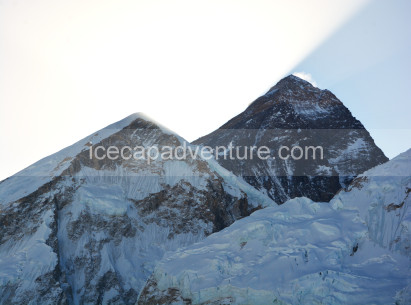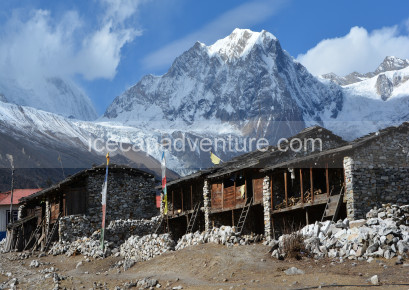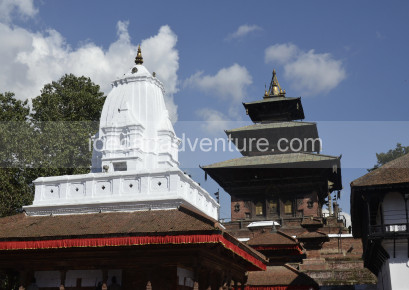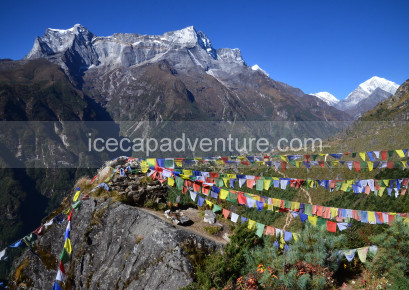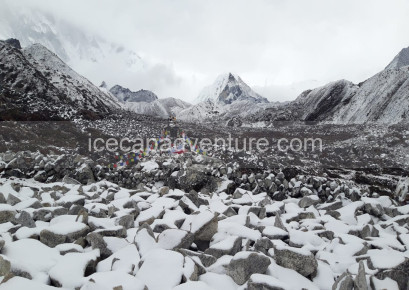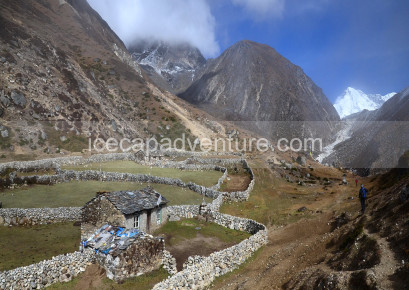.png)
.png)
.png)
.png)
.png)
.png)
.png)
Embarking on the Ultimate Adventure: Three High Passes Trekking in the Everest Region
Challenging Heights and Unprecedented Thrills
Widely acclaimed as one of the most challenging trekking experiences in Nepal, the Three High Passes Trek in the Everest Region beckons adventure enthusiasts from around the world. As a pinnacle adventure destination in the Nepal Himalaya, this trek is not merely a journey but an ultimate goal for trekkers and the beginning of a challenging expedition for climbers. The trek includes traversing Komgma-La Pass at 5,536 meters, Cholapass at 5,420 meters, and Renjola Pass at 5,360 meters. Embarking on this exhilarating adventure via Everest Base Camp, Kalapathar, and Gokyo Lake promises a lifetime of challenges, achievements, and the sheer thrill of being in proximity to the world's tallest mountain.
Three High Passes Trek: A Panoramic Journey: Peaks, Valleys, and Passes
The Three High Passes Trek unfolds as a panoramic journey through the Everest Region, showcasing not only the towering peaks but also the enchanting valleys and challenging high passes. Trekkers are immersed in the stunning beauty of Everest, Lhotse, Nupse, Choyo, Pomori, Makalu, and Ama Dablam, creating a breathtaking backdrop throughout the trek.
Three High Passes Trek: Cultural Odyssey and Monastic Marvels
Beyond the physical challenges, the trek offers a cultural odyssey. The resilient Sherpa people, celebrated for their mountaineering expertise, contribute a unique cultural essence to the journey. Along the route, ancient monasteries, such as the renowned Tengboche Monastery, stand as cultural landmarks, adding spiritual depth to the trekking experience.
Glacial Wonders and Natural Marvels
The Three High Passes Trek goes beyond the conventional, allowing trekkers to navigate glacial wonders like the Ngozumpa Glacier. Challenging high passes like Cho La and Renjo La provide an adrenaline-fueled adventure, enabling trekkers to witness the raw and untouched beauty of the Himalayan landscape.
Expedition Timing and Expert Guidance
Choosing the right time to undertake the Three High Passes Trek is paramount. Optimal seasons in autumn (October and November) and spring (April and May) offer clear skies, mild temperatures, and optimal visibility. The trek is further enriched by the expertise of seasoned mountaineers and guides, ensuring a secure and unforgettable expedition. Embark on the ultimate adventure as you unravel the majesty of the Everest Region through the Three High Passes—a journey of peaks, valleys, and unparalleled thrills.
Trip Highlights:
- Kalapatthar-wonderful viewpoint.
- Everest Three Highest Passes (Kongma La, Cho La, and Renjo-La Pass)
- Namche Bazaar- the beautiful Sherpa's Capital.
- Gokyo RI for the grand view of the Everest Massif.
1
We will be waiting to welcome you at Tribhuvan International Airport, Kathmandu, where you will be greeted with a traditional Nepali flower garland to mark your arrival. After the warm welcome, we will drive you to your hotel—approximately 30 minutes during the day and 20 minutes at night.
Upon reaching Jampa Hotel, you will be offered welcome drinks and biscuits, followed by the settlement of your rooms. Once settled, please join us back in the lobby or meeting hall for a briefing about your trekking and tour program on Three High Passes Trekking, including an introduction to your trekking guide and other relevant details.
After the briefing, you will have the opportunity to check your trekking equipment with your guide, and we will also explain the domestic flight schedule to Lukla.
Note: If you arrive in Kathmandu at night, these activities will be scheduled for the following day after breakfast and meals.
.png)
.png)
.png)
.png)
2
After breakfast at the hotel, you will have time to explore Kathmandu’s cultural heritage sites, such as Kathmandu Durbar Square, Swayambhunath (Monkey Temple), or Boudhanath Stupa, and you will have the day to prepare for your trek.
Our team will assist you in checking your gear and ensuring you have all the necessary equipment for the journey ahead. If you need to buy or rent any trekking gear, we will guide you to the best shops in Thamel, where you can find quality items at reasonable prices.
In the evening, your trekking guide will conduct a final briefing about the trek, including route details, safety measures, and expected weather conditions. Overnight stay at a hotel in Kathmandu.
.png)
.png)
.png)
.png)
3
Your Everest adventure begins early with a scenic 30-minute flight from Kathmandu (1,350m) to Lukla (2,610m). This flight is famous for its breathtaking views of the Himalayas, including glimpses of snow-capped peaks, deep valleys, and terraced hillsides. Upon landing at the Tenzing-Hillary Airport, you’ll meet your trekking crew and prepare for the first day on foot.
From Lukla, the trek to Phakding (2,610m) is a gentle introduction to high-altitude trekking, following the Dudh Koshi River valley. The trail passes through Sherpa villages, suspension bridges, and lush forests, providing a scenic and culturally rich start to your expedition. This first trek helps your body adjust gradually to higher elevations while offering your first views of the surrounding Himalayan peaks.
Highlights of the Day:
-
Scenic mountain flight from Kathmandu to Lukla (30 minutes)
-
Begin trekking through the picturesque Dudh Koshi River valley
-
Pass through Sherpa villages, suspension bridges, and pine forests
-
Enjoy your first Himalayan views and cultural encounters
-
Overnight stay in Phakding with warm meals and comfortable accommodation
.png)
.png)
.png)
.png)
4
After breakfast in Phakding (2,610m), you begin the trek toward Namche Bazaar (3,440m), the bustling Sherpa capital of the Khumbu region. The trail follows the Dudh Koshi River valley, crossing several suspension bridges adorned with colorful prayer flags and passing through small villages like Tok Tok and Benkar, where you’ll experience the local Sherpa culture and hospitality.
As you approach Monjo, you enter Sagarmatha National Park, a UNESCO World Heritage Site. The path gradually ascends, weaving through pine and rhododendron forests and offering your first clear views of Mount Everest, Lhotse, and Nuptse on a clear day. The final climb to Namche Bazaar is steep but rewarding, providing a sense of achievement as you reach this lively mountain hub.
Highlights of the Day:
-
Trek along the Dudh Koshi River and through Sagarmatha National Park
-
Cross suspension bridges and visit small Sherpa villages
-
Enjoy panoramic views of Everest, Lhotse, and Nuptse
-
Explore Namche Bazaar’s vibrant market and cultural life
-
Overnight stay in Namche Bazaar with warm meals and comfortable lodging
.png)
.png)
.png)
.png)
5
Today is an important acclimatization day in Namche Bazaar (3,440m), allowing your body to adjust to the altitude before venturing further into the Everest region. Although called a rest day, it includes a short hike to nearby Khumjung Village (3,790m) or nearby viewpoints, providing gentle altitude gain to support acclimatization.
The trek to Khumjung takes you through Sherpa settlements, mani walls, and prayer flags, offering insight into local culture and traditions. At Khumjung, you can visit the ancient monastery, Sir Edmund Hillary School, and see the famed “Yeti scalp” preserved in the village. On the way back, an optional detour to the Everest View Hotel provides panoramic views of Mount Everest, Lhotse, and Ama Dablam, making this a visually and culturally enriching day.
Highlights of the Day:
-
Short acclimatization hike to Khumjung Village (3,790m)
-
Visit Khumjung Monastery and Sir Edmund Hillary School
-
Panoramic views of Everest, Lhotse, and Ama Dablam from Everest View Hotel
-
Explore Namche Bazaar’s markets, cafes, and Sherpa culture
-
Gentle trekking to aid altitude acclimatization
.png)
.png)
.png)
.png)
6
After breakfast in Namche Bazaar (3,440m), the trek continues toward Tengboche (3,860m), a spiritual and scenic village in the Khumbu region. The trail initially ascends through lush pine and rhododendron forests, offering glimpses of Mount Everest, Lhotse, and Ama Dablam. You’ll pass through small Sherpa settlements and cross several suspension bridges, all adorned with prayer flags and mani walls, reflecting the region’s rich Buddhist culture.
Upon reaching Tengboche, you can visit the famous Tengboche Monastery, the largest monastery in the Khumbu region, where you may witness monks performing prayers and rituals. The monastery is set against a dramatic backdrop of towering peaks, making it a perfect spot for photography and reflection. The village also offers panoramic Himalayan views, especially during sunrise and sunset.
Highlights of the Day:
-
Trek through pine and rhododendron forests with gradual ascent
-
Pass through Sherpa villages with traditional culture and prayer flags
-
Visit Tengboche Monastery and observe Buddhist rituals
-
Panoramic views of Ama Dablam, Everest, Lhotse, and surrounding peaks
-
Overnight stay in Tengboche with warm meals and comfortable lodging
.png)
.png)
.png)
.png)
7
After breakfast in Tengboche (3,860m), the trek today leads to Dingboche (4,410m), moving further into the high alpine region of the Khumbu Valley. The trail descends briefly through forests of pine and rhododendron, crossing the Imja Khola River on a suspension bridge, before gradually ascending past Pangboche Village, one of the oldest Sherpa settlements in the region.
The landscape becomes increasingly barren and rocky as you climb above the tree line, with glacial moraines, alpine meadows, and distant snow-capped peaks surrounding the trail. Dingboche is nestled in the Imja Valley, offering stunning views of Ama Dablam, Island Peak, Lhotse, and Makalu. This village is an ideal stop for acclimatization, allowing trekkers to adjust to higher altitudes before the ascent toward Lobuche.
Highlights of the Day:
-
Trek through forests, suspension bridges, and alpine terrain
-
Pass Pangboche Village and observe Sherpa culture
-
Panoramic views of Ama Dablam, Island Peak, Lhotse, and Makalu
-
Cross the Imja Khola and trek above the tree line
-
Overnight stay in Dingboche with warm meals and comfortable lodges
.
.png)
.png)
.png)
.png)
8
Today is a scheduled rest or acclimatization day, typically at a high-altitude village such as Dingboche (4,410m) or Namche Bazaar (3,440m), depending on your trek stage. This day is crucial for allowing your body to adapt to the thinner air at high elevations, reducing the risk of altitude sickness before proceeding to higher camps or passes.
Although considered a rest day, it often includes optional short hikes to nearby ridges or peaks. These gentle walks help improve oxygen circulation, build stamina, and enhance acclimatization. Trekkers can also take time to explore local villages, interact with Sherpa communities, and enjoy the Himalayan landscape. Meals and lodging are provided in tea houses or lodges, allowing for comfortable rest and recovery.
Highlights of the Day:
-
Gentle acclimatization hikes to nearby ridges or peaks
-
Scenic views of surrounding Himalayan peaks
-
Explore the village and experience local Sherpa culture
-
Rest and prepare physically for the upcoming high-altitude trekking
-
Opportunity to reflect on your journey and enjoy the serenity of the mountains
.png)
.png)
.png)
.png)
9
After breakfast in Dingboche (4,410m), today’s trek leads to Chhukung (4,730m), a scenic alpine village located in the Imja Valley. The trail is moderate in difficulty, gradually ascending through rocky paths, glacial streams, and high-altitude moraines. Along the way, trekkers are treated to panoramic views of Ama Dablam, Lhotse, Island Peak, and Cholatse, making the journey both visually spectacular and rewarding.
Chhukung is a small settlement and serves as a key base for climbers preparing to ascend Island Peak (Imja Tse). The village is surrounded by glaciers and snow-capped peaks, providing a dramatic high-altitude environment that is perfect for acclimatization and short exploration hikes. Tea houses and lodges offer warm meals and comfortable lodging for trekkers.
Highlights of the Day:
-
Gradual ascent from Dingboche to Chhukung through alpine terrain
-
Panoramic views of Ama Dablam, Lhotse, Island Peak, and Cholatse
-
Cross glacial streams and rocky moraines along the route
-
Explore Chhukung village and interact with local Sherpas
-
Overnight stay with warm meals and accommodation in Chhukung
.png)
.png)
.png)
.png)
10
After an early breakfast in Chhukung (4,730m), today is one of the most challenging yet rewarding days of the Everest expedition. The trek begins with a steady ascent toward Kongma La Pass (5,535m), one of the high passes of the region. The trail passes through rocky moraines, glacial streams, and snowfields, demanding good stamina, careful footing, and high-altitude trekking experience.
Reaching Kongma La Pass, trekkers are rewarded with panoramic Himalayan views, including Island Peak, Lhotse, Nuptse, and Everest. The pass is a dramatic high point, offering a sense of achievement and unparalleled photographic opportunities. After a brief rest at the pass, the trail descends gradually toward Lobuche (4,910m), passing glacial terrain and moraine fields. Upon arrival in Lobuche, trekkers can enjoy warm tea house accommodations and hearty meals, preparing for the upcoming trek to Gorak Shep and Everest Base Camp.
Highlights of the Day:
-
Early morning ascent from Chhukung toward Kongma La Pass
-
Cross rocky and glacial terrain at high altitude
-
Panoramic views of Island Peak, Lhotse, Nuptse, and Everest from the pass
-
Descend to Lobuche, experiencing dramatic Himalayan landscapes
-
Overnight stay in Lobuche with warm meals and accommodation
.png)
.png)
.png)
.png)
11
After breakfast in Lobuche (4,910m), today’s trek leads to Gorak Shep (5,140m), the final settlement before Everest Base Camp. The trail is moderate to challenging, gradually ascending along glacial moraines, rocky ridges, and high-altitude terrain. Along the way, trekkers are surrounded by towering peaks like Pumori, Nuptse, and Lingtren, offering breathtaking high Himalayan scenery at every step.
Gorak Shep is a small, windswept village that serves as a base for the final trek to Everest Base Camp and Kala Patthar. Upon arrival, trekkers can rest in tea houses or lodges, enjoy meals, and optionally explore the surrounding area. This settlement provides a crucial high-altitude acclimatization stop before attempting the iconic journey to Everest Base Camp the following day.
Highlights of the Day:
-
Trek through high-altitude moraine trails with stunning Himalayan views
-
Panoramic vistas of Pumori, Nuptse, Lingtren, and surrounding peaks
-
Reach Gorak Shep, the last stop before Everest Base Camp
-
Rest and acclimatize in preparation for EBC or Kala Patthar
-
Experience the dramatic, windswept high-altitude environment
.png)
.png)
.png)
.png)
12
After breakfast in Gorak Shep (5,140m), today’s trek takes you toward Dzongla (4,830m). The trail involves a descent from Gorak Shep, following the glacial moraines of the Khumbu Glacier, and passes through rock-strewn landscapes and high-altitude valleys. Despite being a descent, trekkers need to be cautious due to uneven and rocky terrain, making this day moderate in difficulty.
The trek offers magnificent views of towering peaks, including Pumori, Nuptse, and Ama Dablam, while traversing the isolated and dramatic high-altitude environment. Dzongla is a small settlement providing tea house accommodations and warm meals, making it an ideal stop for rest, acclimatization, and preparation for the next stages of the Everest expedition.
Highlights of the Day:
-
Descend from Gorak Shep along glacial moraines
-
Trek through rocky high-altitude valleys with stunning Himalayan views
-
Panoramic vistas of Pumori, Nuptse, Ama Dablam, and surrounding peaks
-
Overnight stay in Dzongla with warm meals and tea house lodging
-
Opportunity to rest and acclimatize at a high-altitude settlement
.png)
.png)
.png)
.png)
13
After an early breakfast in Dzongla (4,830m), today’s trek is one of the most challenging and spectacular days of the Everest expedition. The journey involves crossing the iconic Cho La Pass (5,420m), connecting the Gokyo Valley to the Khumbu region. The trail is strenuous, requiring physical stamina, careful footing, and acclimatization experience, as it involves steep ascents, rocky terrain, and glacial sections.
The ascent to Cho La Pass rewards trekkers with panoramic Himalayan views, including Cho Oyu, Gyachung Kang, and Everest in the distance. After reaching the pass, the descent toward Thagnak (4,700m) passes through high alpine valleys, glacial moraine, and sparse vegetation, providing a dramatic contrast to the rugged ascent. Upon arrival, Thagnak offers tea house accommodations and warm meals, ideal for resting after this physically demanding day.
Highlights of the Day:
-
Ascend steeply to Cho La Pass (5,420m) with panoramic Himalayan views
-
Cross glacial moraines and high-altitude rocky terrain
-
Descend to Thagnak (4,700m) through alpine valleys and sparse vegetation
-
Spectacular views of Cho Oyu, Gyachung Kang, and Everest
-
Overnight stay in Thagnak with warm meals and lodging
.png)
.png)
.png)
.png)
14
After breakfast in Thagnak (4,700m), the trek today leads to Gokyo (4,790m), a picturesque village in the Gokyo Valley, known for its turquoise glacial lakes and stunning Himalayan vistas. The trail is moderate, with gentle ascents and descents, passing through sparsely vegetated high-altitude terrain, glacial streams, and moraine ridges.
Along the way, trekkers are treated to panoramic views of Cho Oyu, Gyachung Kang, Everest, Lhotse, and Makalu, making it one of the most scenic sections of the Everest region. Upon arrival in Gokyo, trekkers can explore the village and its serene lakes, interact with local Sherpa families, and enjoy tea house accommodations and warm meals, making it a perfect rest and acclimatization stop before further trekking or optional climbs to Gokyo Ri.
Highlights of the Day:
-
Trek through high-altitude valleys and moraine ridges
-
Panoramic views of Everest, Lhotse, Cho Oyu, Gyachung Kang, and Makalu
-
Explore the turquoise Gokyo Lakes and surrounding village
-
Experience Sherpa culture and hospitality
-
Overnight stay in Gokyo with warm meals and lodging
.png)
.png)
.png)
.png)
15
Today in Gokyo (4,790m) is dedicated to acclimatization and exploration of the higher Gokyo Lakes, including the 4th and 5th lakes, which are among the most remote and pristine in the region. These excursions are moderate in difficulty, involving gentle ascents along high-altitude moraine ridges, offering spectacular views of the surrounding Himalayan peaks, including Cho Oyu, Gyachung Kang, and Makalu.
Trekking to the 4th and 5th lakes allows you to experience the tranquil beauty of turquoise glacial waters, observe high-altitude flora, and enjoy serene landscapes far from the main trail. This day also aids further acclimatization, preparing your body for subsequent higher-altitude treks and passes. Upon returning to Gokyo, trekkers can rest in their tea house or lodge and enjoy warm meals while reflecting on the majestic scenery of the Everest region.
Highlights of the Day:
-
Excursion to the 4th and 5th Gokyo Lakes for pristine glacial views
-
Gentle acclimatization hikes along high-altitude moraine ridges
-
Panoramic vistas of Cho Oyu, Gyachung Kang, and Makalu
-
Observe alpine flora and high-altitude landscapes
-
Overnight stay in Gokyo with warm meals and tea house accommodation
.png)
.png)
.png)
.png)
16
After an early breakfast in Gokyo (4,790m), today’s trek is one of the most adventurous and rewarding sections of the journey. The trail ascends steeply to cross the Renjo La Pass (5,360m), one of the three major high passes in the Everest region. This day is challenging due to the long trekking hours, steep climbs, and high altitude, but it rewards trekkers with some of the most breathtaking panoramic views in the Himalayas.
From the top of Renjo La Pass, you’ll witness a magnificent panorama of Everest (8,848.86m), Lhotse, Makalu, Cho Oyu, and the sparkling Gokyo Lakes below — a truly unforgettable sight. The descent from the pass toward Lumde (4,380m) is steep and rocky, winding through remote alpine valleys and rugged landscapes. Lumde is a small settlement offering basic tea house accommodations and warm meals, perfect for rest after this long and exhilarating day.
Highlights of the Day:
-
Challenging ascent to Renjo La Pass (5,360m) with stunning Himalayan views
-
Panoramic vistas of Everest, Lhotse, Makalu, and Cho Oyu
-
Breathtaking view of the turquoise Gokyo Lakes from the pass
-
Descend through remote valleys and rocky terrain to Lumde
-
Experience solitude and the raw beauty of the high Himalayas
.png)
.png)
.png)
.png)
17
After breakfast in Lumde (4,380m), today’s trek is a pleasant descent through remote valleys and traditional Sherpa settlements toward Thame (3,820m) — one of the most culturally rich and historic villages in the Everest region. The trail follows a gentle downhill path alongside a glacial stream, offering beautiful views of snowcapped peaks, rolling hills, and rhododendron forests (in spring).
Thame is renowned for its ancient monastery, perched high on a hill, and for being the birthplace of several famous Sherpa climbers, including Tenzing Norgay. The village preserves traditional Sherpa culture, making it an ideal stop to experience local hospitality and spiritual tranquility after the strenuous high-pass trekking days. Upon arrival, trekkers can relax, explore the Thame Monastery, and enjoy warm meals and cozy accommodation in local tea houses.
Highlights of the Day:
-
Scenic descent from Lumde to the cultural village of Thame
-
Explore the historic Thame Monastery and its spiritual surroundings
-
Experience authentic Sherpa culture and hospitality
-
Enjoy panoramic views of the surrounding Himalayan peaks
-
Rest in comfortable tea house accommodation after long days of high-altitude trekking
.png)
.png)
.png)
.png)
18
After breakfast in Thame (3,820m), today’s trek follows a scenic descent through traditional Sherpa villages, lush forests, and riverside trails toward Manjo (2,740m). The route passes through Thamo village, known for its beautiful monastery and hydroelectric project that powers the Khumbu region. The trek offers stunning views of snowcapped peaks, including Kusum Kanguru and Thamserku, while gradually descending through pine and rhododendron forests filled with Himalayan wildlife and birds.
As you continue along the trail, you’ll re-enter the Sagarmatha National Park, where you may see prayer stones, fluttering prayer flags, and mani walls reflecting the spiritual life of the Sherpa people. Upon reaching Manjo, trekkers can relax at a comfortable tea house, enjoy warm Nepali and Sherpa cuisine, and celebrate the completion of the high Himalayan journey.
Highlights of the Day:
-
Scenic descent through forests, rivers, and Sherpa villages
-
Visit Thamo village and its monastery
-
Panoramic views of Kusum Kanguru, Thamserku, and surrounding peaks
-
Re-enter Sagarmatha National Park and experience Sherpa culture
-
Overnight stay in Manjo with warm meals and cozy lodge accommodation
.png)
.png)
.png)
.png)
19
After breakfast in Manjo (2,740m), today marks the final trekking day of your Everest Expedition journey. The trail follows a gentle descent and gradual ascents along the Dudh Koshi River, passing through lush forests, suspension bridges, and traditional Sherpa villages such as Phakding and Chheplung. The path is lively, often filled with trekkers, porters, and prayer flags, reflecting the warm spirit of the Khumbu region.
As you approach Lukla (2,850m), the trail climbs slightly, offering one last panoramic view of the surrounding Himalayan hills. Upon arrival, you can celebrate the successful completion of your expedition with your trekking team, sharing stories and experiences over warm meals and local drinks. This final evening in Lukla provides a perfect moment of reflection, gratitude, and joy before flying back to Kathmandu the next day.
Highlights of the Day:
-
Final trekking day through beautiful forests and Sherpa villages
-
Cross suspension bridges over the Dudh Koshi River
-
Enjoy scenic views of terraced fields and Himalayan foothills
-
Celebrate the successful completion of your expedition in Lukla
-
Overnight stay in a comfortable tea house or lodge
.png)
.png)
.png)
.png)
20
After an early breakfast in Lukla (2,850m), you’ll take a scenic 30-minute flight back to Kathmandu (1,350m). This short but thrilling flight offers a final aerial view of the majestic Himalayan peaks, including Everest, Lhotse, and Ama Dablam, before descending toward the Kathmandu Valley. Upon arrival at Tribhuvan International Airport, you’ll be transferred to your hotel, where you can relax and enjoy the comforts of city life after weeks in the mountains.
The rest of the day is free for rest, refreshing showers, or exploring the vibrant streets of Thamel, where you can enjoy delicious local food, shop for souvenirs, or simply unwind. This marks the transition from rugged mountain adventure to cultural Kathmandu charm, offering a perfect balance of excitement and relaxation.
Highlights of the Day:
-
Scenic 30-minute mountain flight from Lukla to Kathmandu
-
Panoramic aerial views of Everest and surrounding peaks
-
Smooth airport transfer to your hotel in Kathmandu
-
Free time to relax, shop, or explore the city
-
Comfortable overnight stay at your hotel
.png)
.png)
.png)
.png)
21
Today is a well-deserved rest and leisure day in Kathmandu (1,350m) after completing your epic Everest Expedition. This day is all about relaxation, recovery, and celebration. You can spend the morning unwinding at your hotel, enjoying a leisurely breakfast, or exploring the vibrant streets of Thamel, where colorful shops, cafés, and handicraft stores line the narrow alleys.
Trekkers often use this day for souvenir shopping — from handmade pashminas and traditional Thangka paintings to trekking gear and local jewelry. You can also choose to visit some of Kathmandu’s UNESCO World Heritage Sites, such as Pashupatinath Temple, Boudhanath Stupa, Swayambhunath (Monkey Temple), or Kathmandu Durbar Square, for a cultural immersion into Nepal’s rich history and spirituality.
In the evening, you might enjoy a relaxing dinner at a rooftop restaurant, reflecting on your incredible Himalayan adventure and celebrating your success with fellow climbers or guides.
Highlights of the Day:
-
Relax and recover from the long expedition journey
-
Explore the lively Thamel area for souvenir and gear shopping
-
Optional sightseeing at Kathmandu’s UNESCO World Heritage Sites
-
Experience Nepalese cuisine and culture in the heart of the capital
-
Overnight stay in a comfortable hotel in Kathmandu
.png)
.png)
.png)
.png)
22
Your incredible Himalayan adventure comes to a close today. After breakfast, depending on your flight schedule, our team will transfer you to Tribhuvan International Airport for your final departure. Take with you unforgettable memories, breathtaking mountain experiences, and the pride of conquering one of the world’s most iconic peaks.
As you leave Nepal, you’ll carry not only photographs and souvenirs but also the deep spirit of the Himalayas — the warmth of the Sherpa people, the serenity of the mountains, and the sense of accomplishment that comes from standing among the world’s tallest giants.
Our representative will assist you with airport formalities and bid you a heartfelt “Namaste & See You Again!” hoping to welcome you back for another adventure in the near future.
Highlights of the Day:
-
Hotel breakfast and final packing
-
Private transfer to Tribhuvan International Airport
-
Farewell and final goodbyes with your expedition team
-
International flight from Kathmandu to your next destination
.png)
.png)

Didn’t find what you were looking for?
So why not plan your own trip. It takes only 2 minutes.- Airport pickup and drop-off in Kathmandu.
- Full board meals during the trek include: breakfast, lunch, & dinner.
- Properly 3 times tea and coffee, whatever hot drink is available in a day.
- Full support crew with 1 porter for every 2 trekkers.
- Experienced professional guide.
- Domestic flight tickets from Kathmandu to Lukla to Kathmandu.
- All transportation with AC luxuries deluxe from the starting to ending points of the trip.
- All trekking permits and whatever is needed.
- Full insurance paperwork for guides and porters.
- Trekking maps and notebooks.
- Down sleeping bag (-20), trekking stick / pole, and Potter bag (luggage).
- Down Jacket (the sleeping bag and down jacket must be returned after the completion of the trek).
- First aid kit and oxygen gas (if the group size is above 10 pax) in this case.
- Trekking achievement certificate after completing the treks.
- All international flight tickets, travel insurance and Nepal entry visa fees.
- Lunch and dinner in Kathmandu.
- All hard drinks, such as:whisky, rum, cola, fanta, etc.
- Hot showers, battery charging, and wifi services.
- Any emergency rescue evacuation and extra cost offered by unfavorable circumstances, such as bad weather.
- Extra-night hotel in Kathmandu if arriving early or leaving later than the scheduled itinerary.
- Personal tips for trekking staff.


✅ Clothing
-
Base Layers (Thermal Tops & Bottoms)
-
Trekking Shirts (Long & Short Sleeves)
-
Fleece Jacket / Warm Mid-layer – For insulation.
-
Down Jacket – Essential for nights above 3,500m.
-
Waterproof & Windproof Jacket (with hood).
-
Trekking Pants (lightweight, quick-drying).
-
Warm Trekking Pants (for high altitude).
-
Waterproof Pants (for rain/snow).
-
Underwear – Comfortable, quick-dry.
-
Sports Bras (for women).
✅ Head & Hand Wear
-
Warm Hat / Beanie and Sun Hat / Cap.
-
Buff / Neck Gaiter / Scarf.
-
Sunglasses and Gloves 2 pairs
✅ Footwear
-
Trekking Boots – Sturdy, waterproof, broken-in.
-
Lightweight Shoes / Sandals – For camp/teahouse.
-
Warm Trekking Socks – At least 4–5 pairs.
✅ Sleeping & Bags
-
Sleeping Bag (Down -15°C) and Liner.
-
Duffel Bag (carried by porter).
-
Daypack (30–40L) – For personal items.
-
Rain Cover for Backpack.
✅ Trekking Gear
-
Trekking Poles & Gaiters – For snow or muddy.
-
Headlamp (with extra batteries).
-
Water Bottles (2–3 liters) and Water Purifications.
-
Personal First Aid Kit
-
Snacks / Energy Bars / Dry Fruits.
✅ Accessories & Personal Items
-
Sunscreen (SPF 30–50) and Lip Balm with SPF.
-
Toiletries and Hand Sanitizer.
-
Towel (quick-dry) and Toilet Paper
-
Camera / Power Bank / Solar Charger.
✅ Documents & Money
-
Valid Passport and Visa.
-
Travel Insurance (cover high-altitude & helicopter rescue).
-
Cash (Nepali Rupees) – For personal expenses.
Good to Know – Everest Three High Passes Trekking
-
Best Seasons to Trek:
The best time for the Everest Three High Passes Trek is during spring (March–May) and autumn (September–November). These seasons offer stable weather, clear mountain views, and safe trail conditions. Winter (December–February) brings heavy snow that can block the passes, while monsoon (June–August) causes slippery trails and poor visibility. -
Altitude Awareness:
This trek reaches altitudes above 5,400 meters at Kongma La Pass (5,535m), Cho La Pass (5,420m), and Renjo La Pass (5,360m). It’s a high-altitude and physically demanding trek, requiring careful acclimatization and gradual ascent to prevent acute mountain sickness (AMS). -
Physical Fitness:
The trek is challenging to strenuous, suitable for experienced trekkers with excellent fitness and stamina. Daily walking can range from 6–9 hours, crossing steep ascents, rocky trails, glaciers, and snowy passes. -
Permits Required:
You’ll need a Sagarmatha National Park Entry Permit and a TIMS (Trekkers’ Information Management System) card. Both can be obtained in Kathmandu or at Monjo, the park entrance checkpoint. -
Accommodation and Meals:
Teahouses and lodges along the route offer basic rooms with shared facilities. Meals include dal bhat, soups, noodles, pasta, pancakes, and tea/coffee. At higher elevations, food is simple but nourishing, and prices increase with altitude. -
Drinking Water:
Bottled water is available in villages, but using a reusable water bottle with purification tablets or filters is highly recommended. Boiled water is available in teahouses for a small charge. -
Packing and Gears:
Essential gear includes layered clothing, insulated jacket, waterproof gear, trekking boots, crampons for icy passes, trekking poles, gloves, hat, sunglasses, sleeping bag (rated for -15°C), headlamp, sunscreen, power bank, and personal first aid kit. Proper cold-weather and snow gear are vital for crossing the three passes safely. -
Flight & Transportation:
The trek begins with a flight from Kathmandu to Lukla, then continues through Namche Bazaar, Tengboche, Dingboche, Chhukung, Lobuche, Dzongla, Gokyo, and Thame before looping back to Lukla. The route crosses Kongma La, Cho La, and Renjo La Passes, offering diverse landscapes of glaciers, lakes, and Sherpa villages. -
Travel Insurance:
Comprehensive high-altitude trekking insurance is mandatory, covering medical evacuation, rescue, and emergencies above 5,000 meters. -
Connectivity and Charging:
Internet and mobile network coverage are available in larger villages like Namche Bazaar, Dingboche, and Gokyo, but very limited at high passes. Most teahouses offer charging services for a fee, so carrying a power bank or solar charger is useful. -
Highlight Experience:
The Everest Three High Passes Trek offers a true Himalayan adventure, combining Everest Base Camp, Gokyo Lakes, and the three scenic high passes. Trekkers enjoy panoramic views of Everest, Lhotse, Makalu, Cho Oyu, and Ama Dablam, along with glaciers, turquoise lakes, and remote Sherpa culture — making it one of the most complete and challenging treks in the Everest region.

